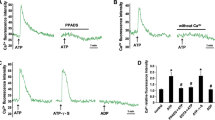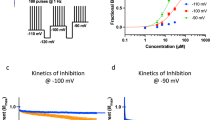Abstract
Although the inhibitory effect of cannabinoids on transient receptor potential vanilloid 1 (TRPV1) channel may explain the efficacy of peripheral cannabinoids in antihyperalgesia and antinociceptive actions, the mechanism for cannabinoid-induced inhibition of TRPV1 in primary sensory neurons is not understood. Therefore, we explored how WIN55,212-2 (WIN, a synthetic cannabinoid) inhibited TRPV1 in rat trigeminal ganglion neurons. A “bell”-shaped concentration-dependent curve was obtained from the effects of WIN on TRPV1 channel. The maximal inhibition on capsaicin-induced current (I cap) by WIN was at a concentration of 10−9 M, and at this concentration I cap was reduced by 95 ± 1.6%. When the concentration of WIN was at 10−6 M, it displayed a stimulatory effect on I cap. In this study, several intracellular signaling transduction pathways were tested to study whether they were involved in the inhibitory effects of WIN on I cap. We found that the inhibitory effect of WIN on I cap was completely reversed by PKA antagonists H-89 and KT5720 as well as by PKC antagonists BIM and staurosporine. It was also found that the inhibitory effect was partly reversed by PKG antagonist PKGi, while G-protein antagonist GDP-βs/pertussis toxin (PTX) and PLC antagonist U-73122 had no effect on the inhibitory effect of WIN on Icap. These results suggest that several intracellular signaling transduction pathways including PKA and PKC systems underlie the inhibitory effects of WIN on I cap; however, G protein-coupled receptors CB1 or CB2 were not involved.




Similar content being viewed by others
References
Matsuda LA, Lolait SJ, Brownstein MJ, Young AC, Bonner TI (1990) Structure of a cannabinoid receptor and functional expression of the cloned cDNA. Nature 346:561–564
Munro S, Thomas KL, Abu-Shaar M (1993) Molecular characterization of a peripheral receptor for cannabinoids. Nature 365:61–65
Zygmunt PM, Petersson J, Andersson DA et al (1999) Vanilloid receptors on sensory nerves mediate the vasodilator action of anandamide. Nature 400:452–457
Jeske NA, Patwardhan AM, Gamper N et al (2006) Cannabinoid WIN 55,212-2 regulates TRPV1 phosphorylation in sensory neurons. J Biol Chem 281:32879–32890
Calignano A, La Rana G, Giuffrida A, Piomelli D (1998) Control of pain initiation by endogenous cannabinoids. Nature 394:277–281
Croxford JL (2003) Therapeutic potential of cannabinoids in CNS disease. CNS Drugs 17:179–202
Malan TP Jr, Ibrahim MM, Lai J et al (2003) CB2 cannabinoid receptor agonists: pain relief without psychoactive effects? Curr Opin Pharmacol 3:62–67
Richardson JD, Kilo S, Hargreaves KM (1998) Cannabinoids reduce hyperalgesia and inflammation via interaction with peripheral CB1 receptors. Pain 75:111–119
Ledent C, Valverde O, Cossu G et al (1999) Unresponsiveness to cannabinoids and reduced addictive effects of opiates in CB1 receptor knockout mice. Science 283:401–404
Price TJ, Helesic G, Parghi D, Hargreaves KM, Flores CM (2003) The neuronal distribution of cannabinoid receptor type 1 in the trigeminal ganglion of the rat. Neuroscience 120:155–162
Bridges D, Rice AS, Egertova M et al (2003) Localisation of cannabinoid receptor 1 in rat dorsal root ganglion using in situ hybridisation and immunohistochemistry. Neuroscience 119:803–812
Mohapatra DP, Nau C (2005) Regulation of Ca2+-dependent desensitization in the vanilloid receptor TRPV1 by calcineurin and cAMP-dependent protein kinase. J Biol Chem 280:13424–13432
Patwardhan AM, Jeske NA, Price TJ et al (2006) The cannabinoid WIN 55,212-2 inhibits transient receptor potential vanilloid 1 (TRPV1) and evokes peripheral antihyperalgesia via calcineurin. Proc Natl Acad Sci USA 103:11393–11398
Akopian AN, Ruparel NB, Patwardhan A, Hargreaves KM (2008) Cannabinoids desensitize capsaicin and mustard oil responses in sensory neurons via TRPA1 activation. J Neurosci 28:1064–1075
Lopshire JC, Nicol GD (1998) The cAMP transduction cascade mediates the prostaglandin E2 enhancement of the capsaicin-elicited current in rat sensory neurons: whole-cell and single-channel studies. J Neurosci 18:6081–6092
Liu L, Chen L, Liedtke W, Simon SA (2007) Changes in osmolality sensitize the response to capsaicin in trigeminal sensory neurons. J Neurophysiol 97:2001–2015
Premkumar LS, Ahern GP (2000) Induction of vanilloid receptor channel activity by protein kinase C. Nature 408:985–990
Cesare P, McNaughton P (1996) A novel heat-activated current in nociceptive neurons and its sensitization by bradykinin. Proc Natl Acad Sci USA 93:15435–15439
Liu L, Simon SA (1996) Capsaicin-induced currents with distinct desensitization and Ca2+ dependence in rat trigeminal ganglion cells. J Neurophysiol 75:1503–1514
Caterina MJ, Schumacher MA, Tominaga M et al (1997) The capsaicin receptor: a heat-activated ion channel in the pain pathway. Nature 389:816–824
Szallasi A, Blumberg PM (1999) Vanilloid (Capsaicin) receptors and mechanisms. Pharmacol Rev 51:159–212
Szallasi A, Cortright DN, Blum CA, Eid SR (2007) The vanilloid receptor TRPV1: 10 years from channel cloning to antagonist proof-of-concept. Nat Rev Drug Discov 6:357–372
Kuster JE, Stevenson JI, Ward SJ, D’Ambra TE, Haycock DA (1993) Aminoalkylindole binding in rat cerebellum: selective displacement by natural and synthetic cannabinoids. J Pharmacol Exp Ther 264:1352–1363
Showalter VM, Compton DR, Martin BR, Abood ME (1996) Evaluation of binding in a transfected cell line expressing a peripheral cannabinoid receptor (CB2): identification of cannabinoid receptor subtype selective ligands. J Pharmacol Exp Ther 278:989–999
Price TJ, Patwardhan A, Akopian AN, Hargreaves KM, Flores CM (2004) Cannabinoid receptor-independent actions of the aminoalkylindole WIN 55,212-2 on trigeminal sensory neurons. Br J Pharmacol 142:257–266
Riddall DR, Leach MJ, Garthwaite J (2006) A novel drug binding site on voltage-gated sodium channels in rat brain. Mol Pharmacol 69:278–287
Bhave G, Zhu W, Wang H et al (2002) cAMP-dependent protein kinase regulates desensitization of the capsaicin receptor (VR1) by direct phosphorylation. Neuron 35:721–731
Brzostowski JA, Kimmel AR (2001) Signaling at zero G: G-protein-independent functions for 7-TM receptors. Trends Biochem Sci 26:291–297
Leader JP, Koe BK, Weissman A (1981) GABA-like actions of levonantradol. J Clin Pharmacol 21:262S–270S
Rubino T, Vigano D, Massi P et al (2000) Chronic delta-9-tetrahydrocannabinol treatment increases cAMP levels and cAMP-dependent protein kinase activity in some rat brain regions. Neuropharmacology England 39:1331–1336
Acknowledgments
This research was partially supported by the National Natural Science Foundation of China 30271500 and 30571537.
Author information
Authors and Affiliations
Corresponding author
Rights and permissions
About this article
Cite this article
Wang, W., Cao, X., Liu, C. et al. Cannabinoid WIN 55,212-2 inhibits TRPV1 in trigeminal ganglion neurons via PKA and PKC pathways. Neurol Sci 33, 79–85 (2012). https://doi.org/10.1007/s10072-011-0620-6
Received:
Accepted:
Published:
Issue Date:
DOI: https://doi.org/10.1007/s10072-011-0620-6




